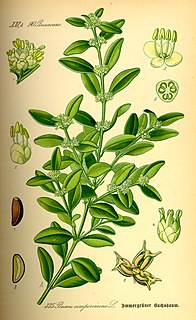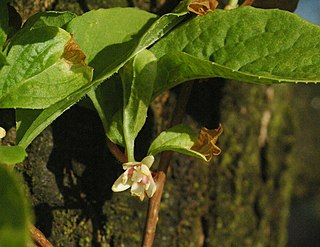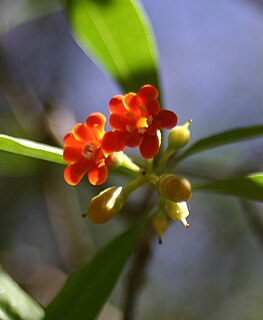
The Fabales are an order of flowering plants included in the rosid group of the eudicots in the Angiosperm Phylogeny Group II classification system. In the APG II circumscription, this order includes the families Fabaceae or legumes, Quillajaceae, Polygalaceae or milkworts, and Surianaceae. Under the Cronquist system and some other plant classification systems, the order Fabales contains only the family Fabaceae. In the classification system of Dahlgren the Fabales were in the superorder Fabiflorae with three families corresponding to the subfamilies of Fabaceae in APG II. The other families treated in the Fabales by the APG II classification were placed in separate orders by Cronquist, the Polygalaceae within its own order, the Polygalales, and the Quillajaceae and Surianaceae within the Rosales.

The Nymphaeales are an order of flowering plants, consisting of three families of aquatic plants, the Hydatellaceae, the Cabombaceae, and the Nymphaeaceae. It is one of the three orders of basal angiosperms, an early-diverging grade of flowering plants. At least 10 morphological characters unite the Nymphaeales. Molecular synapomorphies are also known.

Nymphaeaceae is a family of flowering plants, commonly called water lilies. They live as rhizomatous aquatic herbs in temperate and tropical climates around the world. The family contains five genera with about 70 known species. Water lilies are rooted in soil in bodies of water, with leaves and flowers floating on or emergent from the surface. Leaves are round, with a radial notch in Nymphaea and Nuphar, but fully circular in Victoria and Euryale.

Ranunculales is an order of flowering plants. Of necessity it contains the family Ranunculaceae, the buttercup family, because the name of the order is based on the name of a genus in that family. Ranunculales belongs to a paraphyletic group known as the basal eudicots. It is the most basal clade in this group; in other words, it is sister to the remaining eudicots. Widely known members include poppies, barberries, and buttercups.

Austrobaileyales is an order of flowering plants consisting of about 100 species of woody plants growing as trees, shrubs and lianas. Perhaps the most familiar species is Illicium verum, from which comes the spice star anise. The order belongs to the group of basal angiosperms, the ANA grade, which diverged earlier from the remaining flowering plants. Austrobaileyales is sister to all remaining extant angiosperms outside the ANA grade.

Ceratophyllum is a cosmopolitan genus of flowering plants including four accepted living species in 2016, commonly found in ponds, marshes, and quiet streams in tropical and in temperate regions. It is the only extant genus in the family Ceratophyllaceae, itself the only extant family in the order Ceratophyllales. They are usually called coontails or hornworts, although hornwort is also used for unrelated plants of the division Anthocerotophyta.

Ceratophyllaceae is a cosmopolitan family of flowering plants including one living genus commonly found in ponds, marshes, and quiet streams in tropical and in temperate regions. It is the only extant family in the order Ceratophyllales. Species are commonly called coontails or hornworts, although hornwort is also used for unrelated plants of the division Anthocerotophyta.

The Buxales are a small order of eudicot flowering plants, recognized by the APG IV system of 2016. The order includes the family Buxaceae; the families Didymelaceae and Haptanthaceae may also be recognized or may be included in the Buxaceae. Many members of the order are evergreen shrubs or trees, although some are herbaceous perennials. They have separate "male" (staminate) and "female" (carpellate) flowers, mostly on the same plant. Some species are of economic importance either for the wood they produce or as ornamental plants.

The Potamogetonaceae, commonly referred to as the pondweed family, is an aquatic family of monocotyledonous flowering plants. The roughly 110 known species are divided over six genera. The largest genus in the family by far is Potamogeton, which contains about 100 species.

Nelumbonaceae is a family of aquatic flowering plants. Nelumbo is the sole extant genus, containing Nelumbo lutea, native to North America, and Nelumbo nucifera, widespread in Asia. At least four other genera, Nelumbites, Exnelumbites, Paleonelumbo, and Nelumbago, are known from fossils.

In the APG IV system (2016) for the classification of flowering plants, the name asterids denotes a clade. Common examples include the common daisy, the forget-me-nots, nightshades, the common sunflower, petunias, yacon, morning glory, sweet potato, coffee, lavender, lilac, olive, jasmine, honeysuckle, ash tree, teak, snapdragon, sesame, psyllium, garden sage, table herbs such as mint, basil, and rosemary, and rainforest trees such as Brazil nut.

Schisandraceae is a family of flowering plants with 3 known genera and a total of 92 known species. Such a family has been recognized by most taxonomists, at least for the past several decades. Before that, the plants concerned were assigned to family Magnoliaceae and Illiciaceae.

The Cabombaceae are a family of aquatic, herbaceous flowering plants. The family is recognised as distinct in the Angiosperm Phylogeny Group IV system (2016). The family consists of two genera of aquatic plants, Brasenia and Cabomba, totalling six species.

Theophrastoideae is a small subfamily of flowering plants in the family Primulaceae. It was formerly recognized as a separate family Theophrastaceae. As previously circumscribed, the family consisted of seven genera and 95 species of trees or shrubs, native to tropical regions of the Americas.

Tecophilaeaceae is a family of flowering plants, placed in the order Asparagales of the monocots. It consists of nine genera with a total of 27 species.

Phytolaccaceae is a family of flowering plants. Such a family has been almost universally recognized by taxonomists, although its circumscription has varied. It is also known as the Pokeweed family.
Oncotheca is a genus of tree endemic to New Caledonia. There are two species, Oncotheca balansae and Oncotheca humboldtiana.

Rivina is a genus of flowering plants in the family Petiveriaceae. The name honors German botanist Augustus Quirinus Rivinus (1652-1723).

Trichostigma peruvianum is a species of flowering plant in the family Petiveriaceae. It was formerly placed in the family Phytolaccaceae. It is native to Ecuador, Colombia, and Peru.
Trichostigma octandrum is a species of flowering plant in the family Petiveriaceae. It was formerly placed in the pokeweed family, Phytolaccaceae. It is native to the Neotropics. It is known in English as hoopvine (Florida), black basket wythe, cooper's wythe, basket wiss or basket with, and hoop with. Common French names include liane pannier or liane a barques. Spanish names include bejuco canesta, sotacaballo, and pabello,. The plant has medicinal and fiber uses.

















